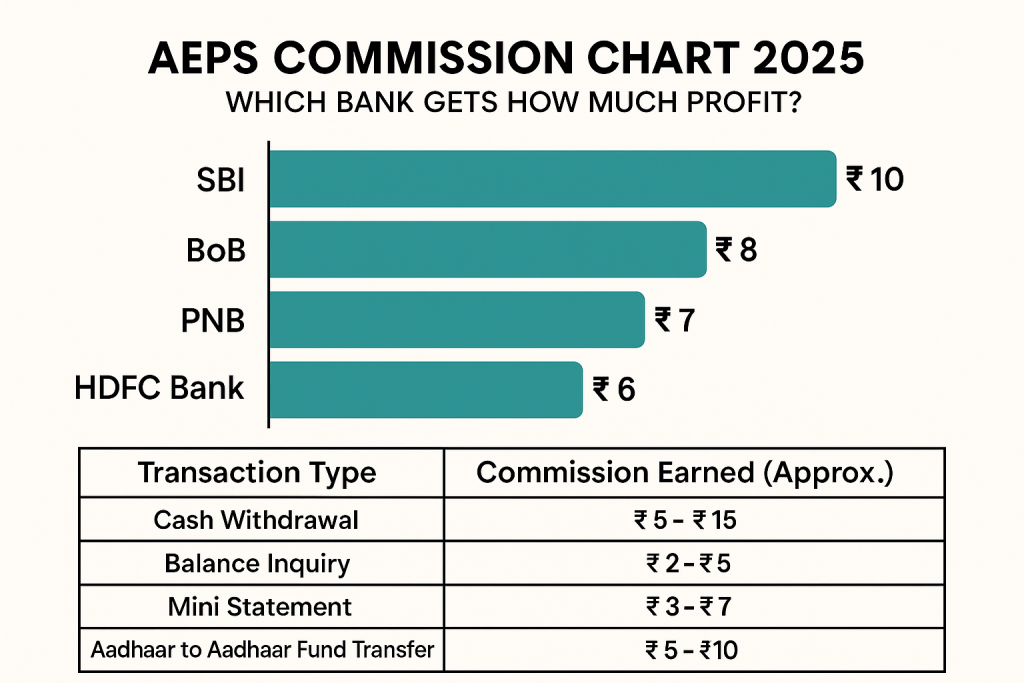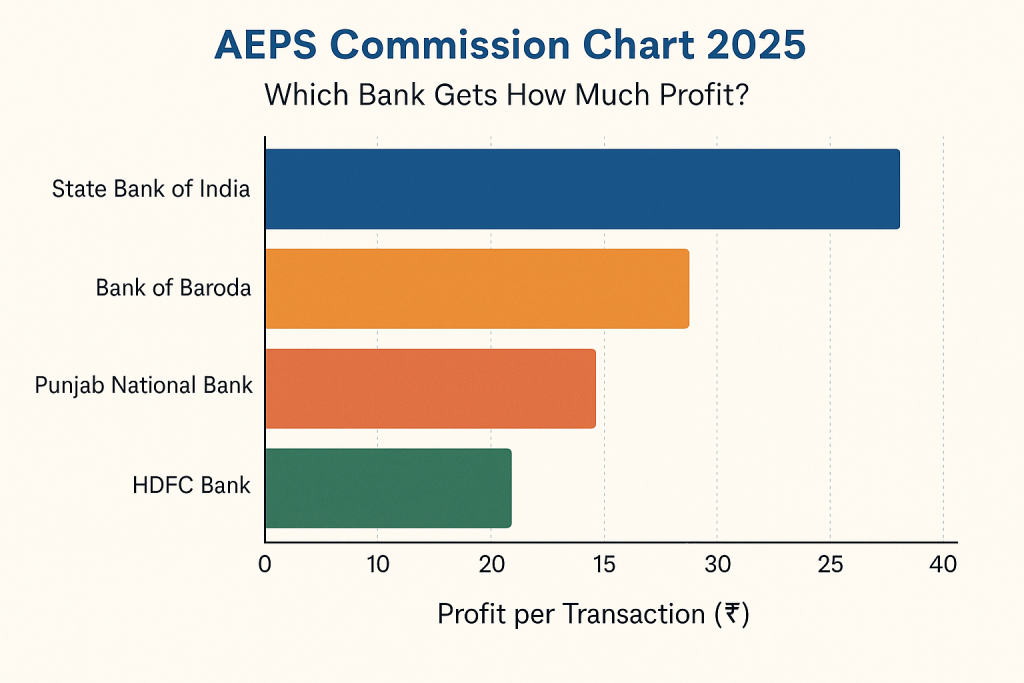The AEPS (Aadhaar Enabled Payment System) has revolutionized digital banking in India, enabling millions to perform cashless transactions using just their Aadhaar number. But have you ever wondered how banks earn from AEPS transactions? The AEPS commission chart 2025 reveals which banks profit the most and how much they make per transaction.
In this detailed guide, we’ll break down the AEPS commission structure for 2025, compare bank-wise earnings, and explain the factors influencing these profits. Whether you’re a banking professional, a business owner, or just curious about digital payments, this article will give you valuable insights.
Understanding AEPS and How Commissions Work
Before diving into the AEPS commission chart 2025, let’s quickly recap how AEPS functions:
-
AEPS (Aadhaar Enabled Payment System) allows users to perform basic banking transactions (cash withdrawal, balance inquiry, fund transfer) using their Aadhaar number and biometric authentication.
-
It is widely used in rural and semi-urban areas where card or smartphone penetration is low.
-
Banks and Business Correspondents (BCs) earn a small fee for every AEPS transaction.
How Banks Earn from AEPS Transactions
Every time a customer withdraws money or checks their balance via AEPS, the following parties earn a commission:
-
Sponsor Bank (The bank facilitating the transaction)
-
Business Correspondent (BC) (Agents enabling transactions in remote areas)
-
NPCI (National Payments Corporation of India) (Regulator of AEPS)
The AEPS commission rates are set by NPCI and revised periodically. The 2025 commission structure is expected to see minor adjustments based on inflation and transaction volume.

AEPS Commission Chart 2025: Bank-Wise Breakdown
The exact AEPS commission rates 2025 may vary slightly, but based on past trends, here’s an estimated breakdown:
| Transaction Type | Commission Earned (Approx.) |
|---|---|
| Cash Withdrawal | ₹5 – ₹15 per transaction |
| Balance Inquiry | ₹2 – ₹5 per transaction |
| Mini Statement | ₹3 – ₹7 per transaction |
| Aadhaar to Aadhaar Fund Transfer | ₹5 – ₹10 per transaction |
Which Banks Earn the Most from AEPS?
Some banks process a higher volume of AEPS transactions due to their extensive BC networks. Here’s a projected ranking for 2025:
-
State Bank of India (SBI) – Largest BC network, highest transaction volume.
-
Bank of Baroda (BoB) – Strong rural presence.
-
Punjab National Bank (PNB) – Popular in North India.
-
HDFC Bank & ICICI Bank – Expanding AEPS services aggressively.
Private banks like HDFC and ICICI are increasing their AEPS reach, but public sector banks still dominate due to their rural penetration.
Factors Influencing AEPS Commissions in 2025
Several factors determine how much banks earn from AEPS:
-
Transaction Volume – More transactions = higher profits.
-
Business Correspondent Network – Banks with more BCs earn more.
-
Rural vs. Urban Usage – Rural areas see higher AEPS usage.
-
NPCI Policy Changes – Slight commission revisions may occur.
Case Study: SBI’s AEPS Dominance
SBI processes over 40% of India’s AEPS transactions due to its massive BC network. In 2024, SBI earned an estimated ₹300-400 crore annually from AEPS commissions. With increased adoption, this could rise in 2025.

How Can Businesses Benefit from AEPS Commissions?
If you’re a Kirana store owner, BC agent, or small bank, you can earn via AEPS by:
-
Becoming a Business Correspondent (Earn ₹2-₹15 per transaction).
-
Offering AEPS services in your shop (Extra income stream).
-
Partnering with banks to increase transaction volume.
Future of AEPS: Will Commissions Increase in 2025?
With India’s push for digital payments, AEPS usage is growing. However, NPCI may slightly reduce commissions to promote affordability. Banks will likely compensate by increasing transaction volume.
Frequently Asked Questions (FAQs)
1. What is the AEPS commission rate for cash withdrawal in 2025?
The expected AEPS cash withdrawal commission in 2025 is ₹5-₹15 per transaction, depending on the bank.
2. Which bank gives the highest AEPS commission?
SBI, PNB, and Bank of Baroda are among the top earners due to their vast BC networks.
3. Can individuals earn from AEPS commissions?
Yes, by becoming a Business Correspondent (BC) or offering AEPS services at your shop.
4. Will AEPS commissions decrease in 2025?
NPCI may slightly reduce rates, but higher transaction volumes will keep profits stable.
Conclusion: AEPS Commission in 2025 – A Lucrative Model
The AEPS commission chart 2025 shows that banks with strong rural networks (like SBI, PNB, BoB) continue to dominate. While private banks are catching up, public sector banks remain the biggest beneficiaries.
For small businesses and BC agents, AEPS remains a steady income source. As digital payments grow, AEPS commissions will remain a key revenue stream for banks and agents alike.
Disclaimer
This article is for educational purposes only. The AEPS commission rates 2025 are estimates based on industry trends. For official updates, refer to NPCI guidelines. If you have any concerns regarding this content, please visit our DMCA page for removal requests. Always verify ownership and compliance before using any financial data.
